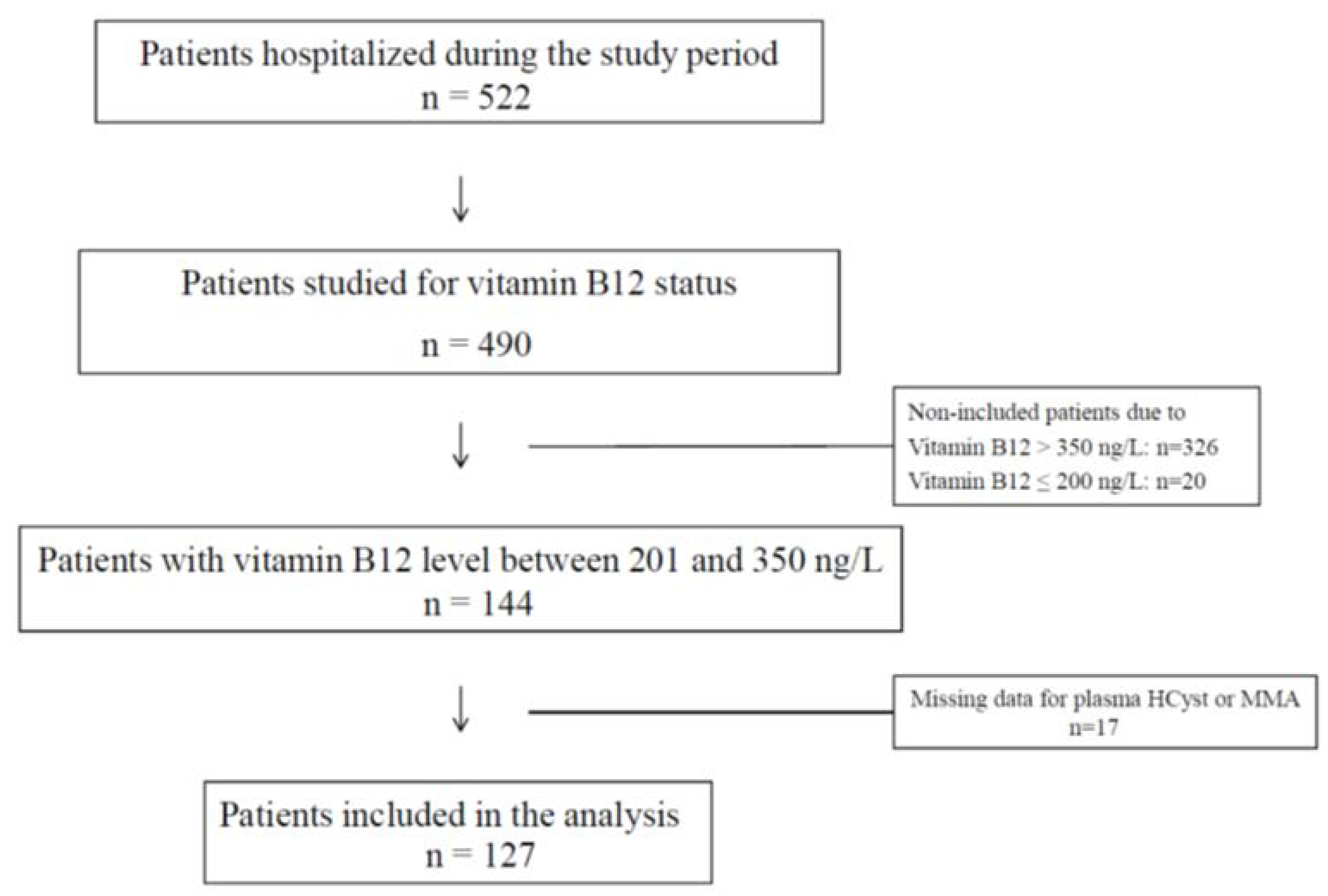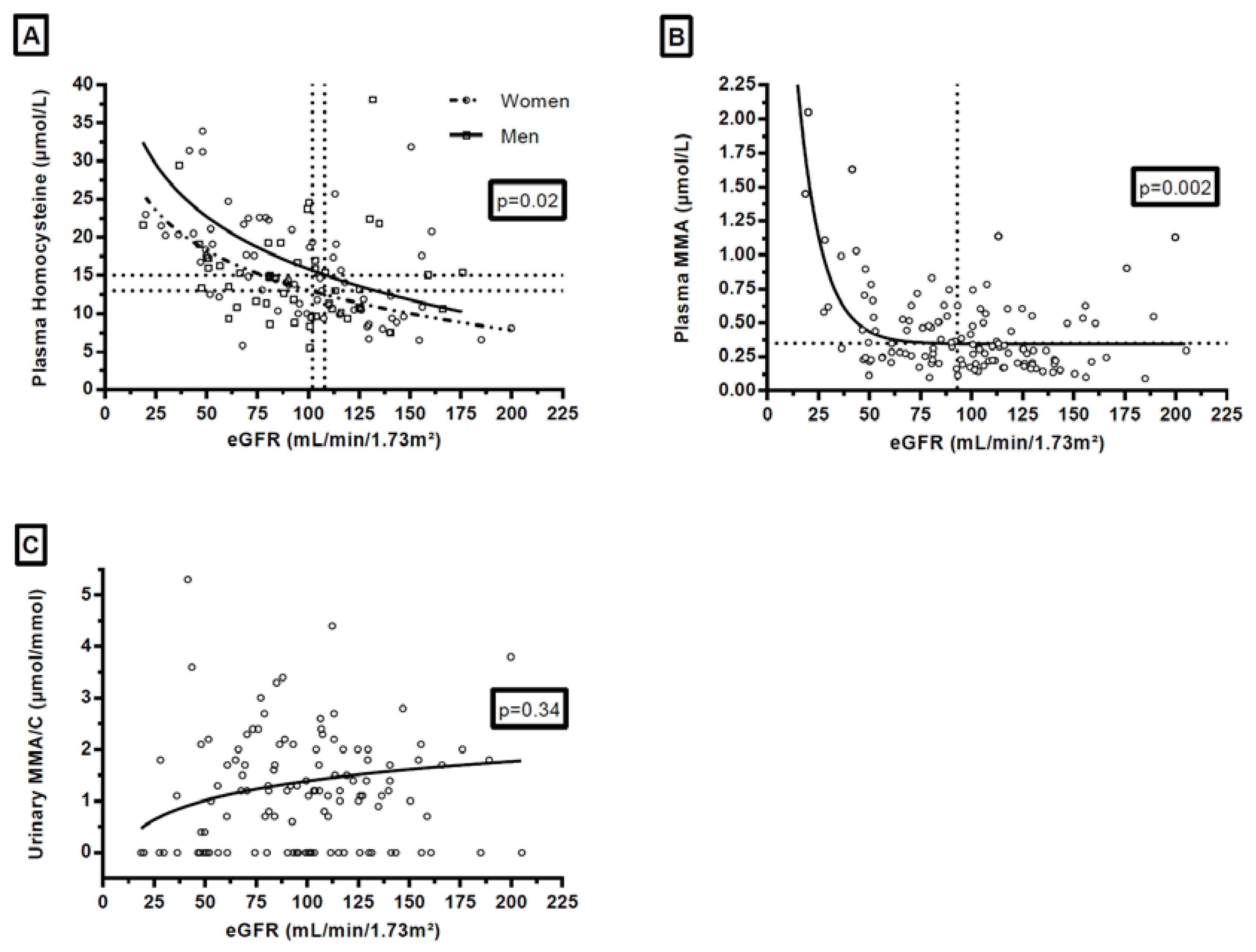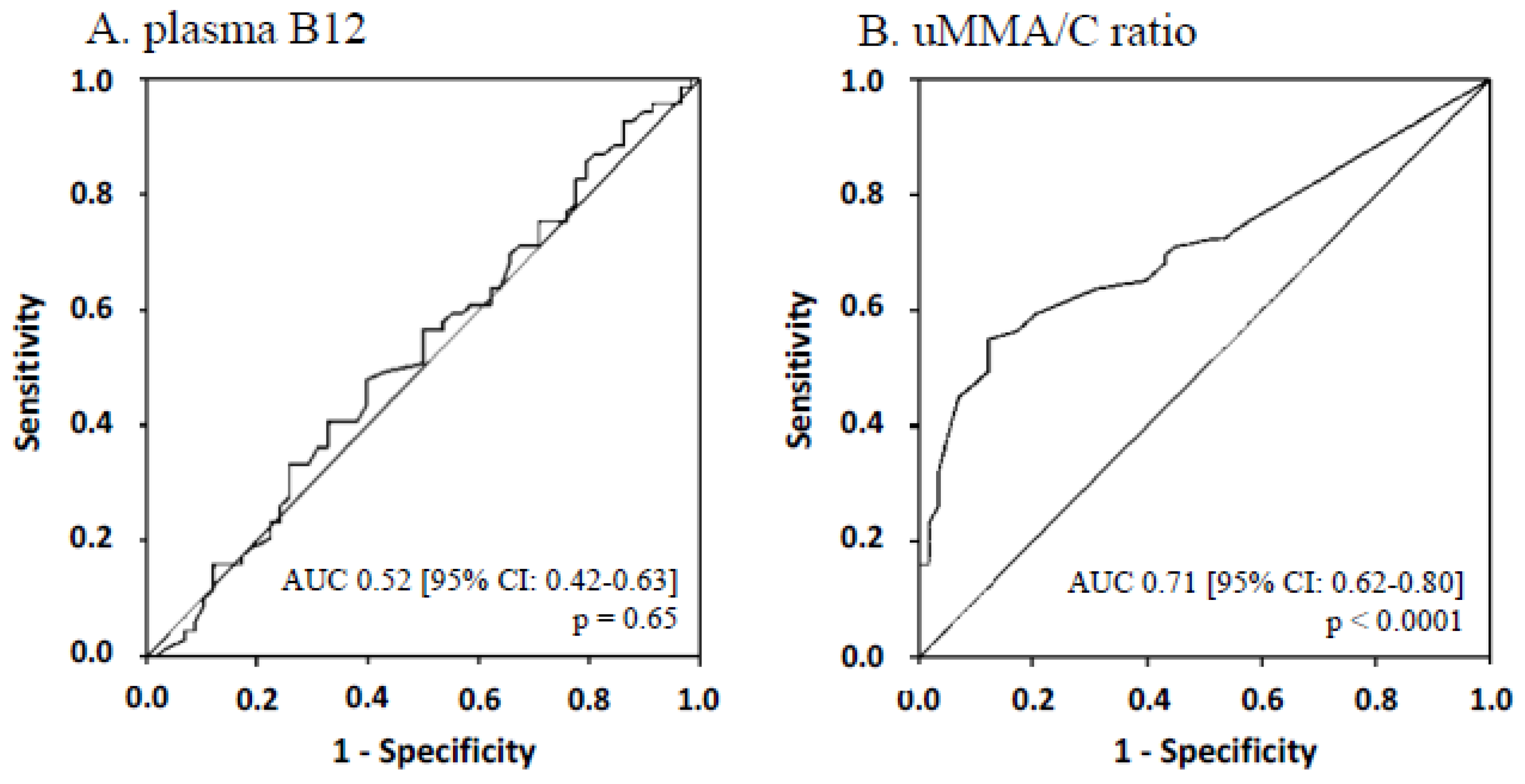Diagnostic Performances of Urinary Methylmalonic Acid/Creatinine Ratio in Vitamin B12 Deficiency
Abstract
1. Introduction
2. Materials and Methods
2.1. Ethics
2.2. Study Population
2.3. Data Collection
2.4. Biological Assays
2.4.1. Plasma Vitamin B12
2.4.2. Plasma Homocysteine
2.4.3. Plasma Methylmalonic Acid
2.4.4. Urinary Methylmalonic Acid
2.5. Definition for Vitamin B12 Deficiency
2.6. Statistical Analysis
3. Results
3.1. The Study Population
3.2. Modeling of Relation between the Creatinine Clearance and the Biochemical Parameters of Interest
3.3. Influence of the Renal Function on Plasma Homocysteine, Plasma Methylmalonic Acid and Urinary Methylmalonic Acid to Creatinine Ratio
3.4. Diagnosis Performances for Plasma B12, Plasma Homocysteine, Plasma Methylmalonic Acid and Urinary Methylmalonic Acid to Creatinine Ratio
4. Discussion
Supplementary Materials
Author Contributions
Funding
Acknowledgments
Conflicts of Interest
References
- Vidal-Alaball, J.; Butler, C.C.; Cannings-John, R.; Goringe, A.; Hood, K.; McCaddon, A.; McDowell, I.; Papaioannou, A. Oral vitamin B12 versus intramuscular vitamin B12 for vitamin B12 deficiency. Cochrane Database Syst. Rev. 2005, 3, CD004655. [Google Scholar] [CrossRef]
- Butler, C.C.; Vidal-Alaball, J.; Cannings-John, R.; McCaddon, A.; Hood, K.; Papaioannou, A.; Mcdowell, I.; Goringe, A. Oral vitamin B12 versus intramuscular vitamin B12 for vitamin B12 deficiency: A systematic review of randomized controlled trials. Fam. Pract. 2006, 23, 279–285. [Google Scholar] [CrossRef] [PubMed]
- Mézière, A.; Audureau, E.; Vairelles, S.; Krypciak, S.; Dicko, M.; Monié, M.; Giraudier, S. B12 deficiency increases with age in hospitalized patients: A study on 14,904 samples. J. Gerontol. A Biol. Sci. Med. Sci. 2014, 69, 1576–1585. [Google Scholar] [CrossRef] [PubMed]
- Stabler, S.P. Vitamin B12 deficiency. N. Engl. J. Med. 2013, 368, 2041–2042. [Google Scholar] [CrossRef]
- Klee, G.G. Cobalamin and folate evaluation: Measurement of methylmalonic acid and homocysteine vs. vitamin B and folate. Clin. Chem. 2000, 46, 1277–1283. [Google Scholar] [CrossRef] [PubMed]
- Scarpa, E.; Candiotto, L.; Sartori, R.; Radossi, P.; Maschio, N.; Tagariello, G. Undetected vitamin B12 deficiency due to false normal assay results. Blood Transfus. Trasfus. Sangue 2013, 11, 627–629. [Google Scholar] [CrossRef]
- Olson, S.R.; Deloughery, T.G.; Taylor, J.A. Time to abandon the serum cobalamin level for diagnosing vitamin B12 deficiency. Blood 2016, 128, 2447. [Google Scholar] [CrossRef]
- Banerjee, R.V.; Matthews, R.G. Cobalamin-dependent methionine synthase. FASEB J. 1990, 4, 1450–1459. [Google Scholar] [CrossRef] [PubMed]
- Takahashi-Iñiguez, T.; García-Hernandez, E.; Arreguín-Espinosa, R.; Flores, M.E. Role of vitamin B12 on methylmalonyl-CoA mutase activity. J. Zhejiang Univ. Sci. B 2012, 13, 423–437. [Google Scholar] [CrossRef]
- Carmel, R. How I treat cobalamin (vitamin B12) deficiency. Blood 2008, 112, 2214–2221. [Google Scholar] [CrossRef]
- Hannibal, L.; Lysne, V.; Bjørke-Monsen, A.-L.; Behringer, S.; Grünert, S.C.; Spiekerkoetter, U.; Jacobsen, D.W.; Blom, H.J. Corrigendum: Biomarkers and algorithms for the diagnosis of vitamin B12 deficiency. Front. Mol. Biosci. 2017, 4. [Google Scholar] [CrossRef]
- Selhub, J.; Jacques, P.F.; Wilson, P.W.; Rush, D.; Rosenberg, I.H. Vitamin status and intake as primary determinants of homocysteinemia in an elderly population. JAMA 1993, 270, 2693–2698. [Google Scholar] [CrossRef] [PubMed]
- Clarke, R.; Refsum, H.; Birks, J.; Evans, J.G.; Johnston, C.; Sherliker, P.; Ueland, P.M.; Schneede, J.; McPartlin, J.; Nexo, E.; et al. Screening for vitamin B-12 and folate deficiency in older persons. Am. J. Clin. Nutr. 2003, 77, 1241–1247. [Google Scholar] [CrossRef] [PubMed]
- Clarke, R.; Grimley Evans, J.; Schneede, J.; Nexo, E.; Bates, C.; Fletcher, A.; Prentice, A.; Johnston, C.; Ueland, P.M.; Refsum, H.; et al. Vitamin B12 and folate deficiency in later life. Age Ageing 2004, 33, 34–41. [Google Scholar] [CrossRef] [PubMed]
- Arnadottir, M.; Hultberg, B.; Nilsson-Ehle, P.; Thysell, H. The effect of reduced glomerular filtration rate on plasma total homocysteine concentration. Scand. J. Clin. Lab. Investig. 1996, 56, 41–46. [Google Scholar] [CrossRef] [PubMed]
- Ozmen, B.; Ozmen, D.; Parildar, Z.; Mutaf, I.; Turgan, N.; Bayindir, O. Impact of renal function or folate status on altered plasma homocysteine levels in hypothyroidism. Endocr. J. 2006, 53, 119–124. [Google Scholar] [CrossRef]
- Bates, C.J.; Schneede, J.; Mishra, G.; Prentice, A.; Mansoor, M.A. Relationship between methylmalonic acid, homocysteine, vitamin B12 intake and status and socio-economic indices, in a subset of participants in the british national diet and nutrition survey of people aged 65 y and over. Eur. J. Clin. Nutr. 2003, 57, 349–357. [Google Scholar] [CrossRef]
- Van Loon, S.L.; Wilbik, A.M.; Kaymak, U.; van den Heuvel, E.R.; Scharnhorst, V.; Boer, A.-K. Improved testing for vitamin B12 deficiency: Correcting MMA for EGFR reduces the number of patients classified as vitamin B12 Deficient. Ann. Clin. Biochem. 2018, 55, 685–692. [Google Scholar] [CrossRef]
- Matchar, D.B.; Feussner, J.R.; Millington, D.S.; Wilkinson, R.H.; Watson, D.J.; Gale, D. Isotope-dilution assay for urinary methylmalonic acid in the diagnosis of vitamin B12 deficiency. A prospective clinical evaluation. Ann. Intern. Med. 1987, 106, 707–710. [Google Scholar] [CrossRef]
- Norman, E.J. Urinary methylmalonic acid to detect vitamin B12 deficiency. JAMA 1995, 273, 1420. [Google Scholar] [CrossRef]
- Kwok, T.; Cheng, G.; Lai, W.K.; Poon, P.; Woo, J.; Pang, C.P. Use of fasting urinary methylmalonic acid to screen for metabolic vitamin B12 deficiency in older persons. Nutrition 2004, 20, 764–768. [Google Scholar] [CrossRef] [PubMed]
- Rasmussen, K.; Moelby, L.; Jensen, M.K. Studies on methylmalonic acid in humans. II. Relationship between concentrations in serum and urinary excretion, and the correlation between serum cobalamin and accumulation of methylmalonic acid. Clin. Chem. 1989, 35, 2277–2280. [Google Scholar] [CrossRef] [PubMed]
- Gültepe, M.; Özcan, Ö.; Avşar, K.; Çetin, M.; Özdemir, A.S.; Gök, M. Urine methylmalonic acid measurements for the assessment of cobalamin deficiency related to neuropsychiatric disorders. Clin. Biochem. 2003, 36, 275–282. [Google Scholar] [CrossRef]
- Flatley, J.E.; Garner, C.M.; Al-Turki, M.; Manning, N.J.; Olpin, S.E.; Barker, M.E.; Powers, H.J. Determinants of urinary methylmalonic acid concentration in an elderly population in the United Kingdom. Am. J. Clin. Nutr. 2012, 95, 686–693. [Google Scholar] [CrossRef]
- Levey, A.S.; Coresh, J.; Greene, T.; Stevens, L.A.; Zhang, Y.L.; Hendriksen, S.; Kusek, J.W.; Van Lente, F.; Chronic Kidney Disease Epidemiology Collaboration. Using standardized serum creatinine values in the modification of diet in renal disease study equation for estimating glomerular filtration rate. Ann. Intern. Med. 2006, 145, 247–254. [Google Scholar] [CrossRef]
- Andrès, E.; Loukili, N.H.; Noel, E.; Kaltenbach, G.; Abdelgheni, M.B.; Perrin, A.E.; Noblet-Dick, M.; Maloisel, F.; Schlienger, J.-L.; Blicklé, J.-F. Vitamin B12 (cobalamin) deficiency in elderly patients. CMAJ 2004, 171, 251–259. [Google Scholar] [CrossRef]
- WHO. Serum and Red Blood Cell Folate Concentrations for Assessing Folate Status in Populations. Available online: http://www.who.int/nutrition/publications/micronutrients/indicators_serum_RBC_folate/en/ (accessed on 9 June 2020).
- Miller, J.W.; Garrod, M.G.; Rockwood, A.L.; Kushnir, M.M.; Allen, L.H.; Haan, M.N.; Green, R. Measurement of total vitamin B12 and holotranscobalamin, singly and in combination, in screening for metabolic vitamin B12 deficiency. Clin. Chem. 2006, 52, 278–285. [Google Scholar] [CrossRef]
- Lee, S.M.; Oh, J.; Chun, M.R.; Lee, S.Y. Methylmalonic acid and homocysteine as indicators of vitamin B12 deficiency in patients with gastric cancer after gastrectomy. Nutrients 2019, 11, 450. [Google Scholar] [CrossRef]
- Bozdogan, H. Model selection and Akaike’s Information Criterion (AIC): The general theory and its analytical extensions. Psychometrika 1987, 52, 345–370. [Google Scholar] [CrossRef]
- Oh, R.; Brown, D.L. Vitamin B12 deficiency. Am. Fam. Phys. 2003, 67, 979–986. [Google Scholar]
- Langan, R.C.; Goodbred, A.J. Vitamin B12 deficiency: Recognition and management. Am. Fam. Phys. 2017, 96, 384–389. [Google Scholar]
- Bjørke Monsen, A.L.; Ueland, P.M. Homocysteine and methylmalonic acid in diagnosis and risk assessment from infancy to adolescence. Am. J. Clin. Nutr. 2003, 78, 7–21. [Google Scholar] [CrossRef]
- Pietrzik, K.; Brönstrup, A. Vitamins B12, B6 and folate as determinants of homocysteine concentration in the healthy population. Eur. J. Pediatr. 1998, 157, S135–S138. [Google Scholar] [CrossRef] [PubMed]
- Elias, M.F.; Robbins, M.A.; Budge, M.M.; Elias, P.K.; Brennan, S.L.; Johnston, C.; Nagy, Z.; Bates, C.J. Homocysteine, folate, and vitamins B6 and B12 blood levels in relation to cognitive performance: The Maine-Syracuse study. Psychosom. Med. 2006, 68, 547–554. [Google Scholar] [CrossRef] [PubMed]
- Chuang, C.Z.; Boyles, A.; Legardeur, B.; Su, J.; Japa, S.; Lopez-S, A. Effects of riboflavin and folic acid supplementation on plasma homocysteine levels in healthy subjects. Am. J. Med. Sci. 2006, 331, 65–71. [Google Scholar] [CrossRef] [PubMed]
- Bolann, B.J.; Solli, J.D.; Schneede, J.; Grøttum, K.A.; Loraas, A.; Stokkeland, M.; Stallemo, A.; Schjøth, A.; Bie, R.B.; Refsum, H.; et al. Evaluation of indicators of cobalamin deficiency defined as cobalamin-induced reduction in increased serum methylmalonic acid. Clin. Chem. 2000, 46, 1744–1750. [Google Scholar] [CrossRef] [PubMed]
- Wollesen, F.; Brattström, L.; Refsum, H.; Ueland, P.M.; Berglund, L.; Berne, C. Plasma total homocysteine and cysteine in relation to glomerular filtration rate in diabetes mellitus. Kidney Int. 1999, 55, 1028–1035. [Google Scholar] [CrossRef]
- Bostom, A.G.; Culleton, B.F. Hyperhomocysteinemia in chronic renal disease. J. Am. Soc. Nephrol. JASN 1999, 10, 891–900. [Google Scholar]
- Ninomiya, T.; Kiyohara, Y.; Kubo, M.; Tanizaki, Y.; Tanaka, K.; Okubo, K.; Nakamura, H.; Hata, J.; Oishi, Y.; Kato, I.; et al. Hyperhomocysteinemia and the development of chronic kidney disease in a general population: The Hisayama study. Am. J. Kidney Dis. Off. J. Natl. Kidney Found. 2004, 44, 437–445. [Google Scholar] [CrossRef]
- Cianciolo, G.; De Pascalis, A.; Di Lullo, L.; Ronco, C.; Zannini, C.; La Manna, G. Folic acid and homocysteine in chronic kidney disease and cardiovascular disease progression: Which comes first? Cardiorenal Med. 2017, 7, 255–266. [Google Scholar] [CrossRef]
- Loikas, S.; Koskinen, P.; Irjala, K.; Löppönen, M.; Isoaho, R.; Kivelä, S.-L.; Pelliniemi, T.-T. Renal impairment compromises the use of total homocysteine and methylmalonic acid but not total vitamin B12 and holotranscobalamin in screening for vitamin B12 deficiency in the aged. Clin. Chem. Lab. Med. 2007, 45, 197–201. [Google Scholar] [CrossRef]
- Fedosov, S.N. Biochemical markers of vitamin B12 deficiency combined in one diagnostic parameter: The age-dependence and association with cognitive function and blood hemoglobin. Clin. Chim. Acta 2013, 422, 47–53. [Google Scholar] [CrossRef] [PubMed]
- Fedosov, S.N.; Brito, A.; Miller, J.W.; Green, R.; Allen, L.H. Combined indicator of vitamin B12 status: Modification for missing biomarkers and folate status and recommendations for revised cut-points. Clin. Chem. Lab. Med. CCLM 2015, 53, 1215–1225. [Google Scholar] [CrossRef] [PubMed]
- Norman, E.J.; Morrison, J.A. Screening elderly populations for cobalamin (vitamin B12) deficiency using the urinary methylmalonic acid assay by gas chromatography mass spectrometry. Am. J. Med. 1993, 94, 589–594. [Google Scholar] [CrossRef]
- Aparicio-Ugarriza, R.; Palacios, G.; Alder, M.; González-Gross, M.A. Review of the cut-off points for the diagnosis of vitamin B12 deficiency in the general population. Clin. Chem. Lab. Med. 2015, 53, 1149–1159. [Google Scholar] [CrossRef]
- Jacobsen, D.W.; Gatautis, V.J.; Green, R.; Robinson, K.; Savon, S.R.; Secic, M.; Ji, J.; Otto, J.M.; Taylor, L.M. Rapid HPLC determination of total homocysteine and other thiols in serum and plasma: Sex differences and correlation with cobalamin and folate concentrations in healthy subjects. Clin. Chem. 1994, 40, 873–881. [Google Scholar] [CrossRef] [PubMed]
- Rasmussen, K.; Møller, J.; Lyngbak, M.; Pedersen, A.M.; Dybkjaer, L. Age- and gender-specific reference intervals for total homocysteine and methylmalonic acid in plasma before and after vitamin supplementation. Clin. Chem. 1996, 42, 630–636. [Google Scholar] [CrossRef]
- Hvas, A.M.; Ellegaard, J.; Nexø, E. Increased plasma methylmalonic acid level does not predict clinical manifestations of vitamin B12 deficiency. Arch. Intern. Med. 2001, 161, 1534–1541. [Google Scholar] [CrossRef]
- Kim, H.; Deloughery, E.P.; Algeciras-Schimnich, A.; Kumar, N.; Pruthi, R.K. Measurement of vitamin B12 and serum methylmalonic acid levels: Role of stepwise cascade testing in diagnosing vitamin B12 deficiency. Blood 2018, 132, 4688. [Google Scholar] [CrossRef]
- Vogiatzoglou, A.; Oulhaj, A.; Smith, A.D.; Nurk, E.; Drevon, C.A.; Ueland, P.M.; Vollset, S.E.; Tell, G.S.; Refsum, H. Determinants of plasma methylmalonic acid in a large population: Implications for assessment of vitamin B12 status. Clin. Chem. 2009, 55, 2198–2206. [Google Scholar] [CrossRef]



| Characteristics | Whole Population | B12 Deficiency | No B12 Deficiency |
|---|---|---|---|
| (n = 127) | (n = 69) | (n = 58) | |
| General characteristics | |||
| Age (years) | 66 (44–81) | 74 (55–83) | 60 (39–73) |
| Gender (female) | 77 (60.6%) | 48 (69.6%) | 29 (50%) |
| BMI (kg/m²) | 25.1 (22.3–28.5) | 25.5 (22.4–29.0) | 24.7 (22.4–28.0) |
| Tobacco misuse | 36 (28.3%) | 17 (24.6%) | 19 (32.8%) |
| Alcohol misuse | 8 (6.3%) | 6 (8.7%) | 2 (3.4%) |
| Biochemical Profiles | |||
| eGFR MDRD (mL/min/1.73 m2) | 99.5 (70.1–123.7) | 88.1 (52.9–113.2) | 105.3 (81.2–127.0) |
| Plasma B12 (ng/L) | 291 (260–314) | 291 (261–315) | 290 (260–310) |
| Plasma Folate (µg/L) | 5.6 (3.7–7.4) | 4.7 (3.5–7.0) | 5.85 (4.20–7.93) |
| Plasma MMA (mmol/L) | 0.32 (0.22–0.54) | 0.53 (0.38–0.71) | 0.23 (0.18–0.28) |
| Plasma HCyst (µmol/L) | 14.7 (10.7–19.3) | 19.1 (14.4–22.5) | 11.2 (9.4–14.2) |
| Urinary MMA (µmol/L) | 8.3 (0.0–14.9) | 10.1 (0.0–15.2) | 5.9 (0.0–13.9) |
| Urinary Creatinine (mmol/L) | 6.5 (3.9–10.2) | 6.1 (3.9–8.3) | 7.8 (4.2–12.1) |
| uMMA/C ratio (µmol/mmol) | 1.1 (0.0–1.8) | 1.6 (0.0–2.2) | 0.7 (0.0–1.2) |
© 2020 by the authors. Licensee MDPI, Basel, Switzerland. This article is an open access article distributed under the terms and conditions of the Creative Commons Attribution (CC BY) license (http://creativecommons.org/licenses/by/4.0/).
Share and Cite
Supakul, S.; Chabrun, F.; Genebrier, S.; N’Guyen, M.; Valarche, G.; Derieppe, A.; Villoteau, A.; Lacombe, V.; Urbanski, G. Diagnostic Performances of Urinary Methylmalonic Acid/Creatinine Ratio in Vitamin B12 Deficiency. J. Clin. Med. 2020, 9, 2335. https://doi.org/10.3390/jcm9082335
Supakul S, Chabrun F, Genebrier S, N’Guyen M, Valarche G, Derieppe A, Villoteau A, Lacombe V, Urbanski G. Diagnostic Performances of Urinary Methylmalonic Acid/Creatinine Ratio in Vitamin B12 Deficiency. Journal of Clinical Medicine. 2020; 9(8):2335. https://doi.org/10.3390/jcm9082335
Chicago/Turabian StyleSupakul, Sopak, Floris Chabrun, Steve Genebrier, Maximilien N’Guyen, Guillaume Valarche, Arthur Derieppe, Adeline Villoteau, Valentin Lacombe, and Geoffrey Urbanski. 2020. "Diagnostic Performances of Urinary Methylmalonic Acid/Creatinine Ratio in Vitamin B12 Deficiency" Journal of Clinical Medicine 9, no. 8: 2335. https://doi.org/10.3390/jcm9082335
APA StyleSupakul, S., Chabrun, F., Genebrier, S., N’Guyen, M., Valarche, G., Derieppe, A., Villoteau, A., Lacombe, V., & Urbanski, G. (2020). Diagnostic Performances of Urinary Methylmalonic Acid/Creatinine Ratio in Vitamin B12 Deficiency. Journal of Clinical Medicine, 9(8), 2335. https://doi.org/10.3390/jcm9082335







